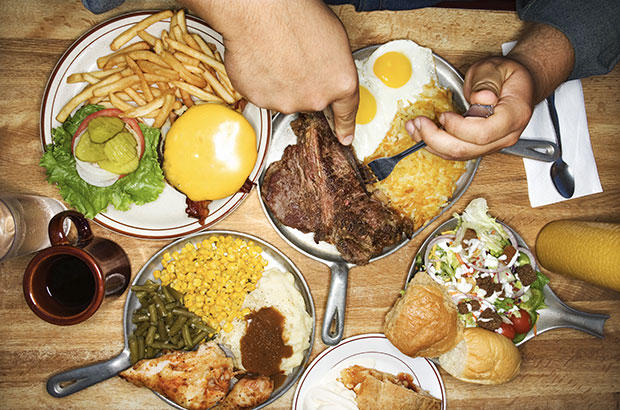How to Lose Weight by Eating Slowly
If you're trying to lose weight, eating slowly and more mindfully can help you eat less and lose weight. Recent research has proven that it takes time for the brain to realize that it is no longer hungry. When you consume your food quickly, your brain may fail to register how much you've actually eaten and may cause you to end up eating too much. Many studies have shown that eating more slowly and more mindfully can help you eat less and manage your weight.[1] Incorporate some easy ways to slow yourself down during meal time to help manage your weight more effectively.
Steps
Part 1 Eating Slowly
-
1
Take 20 – 30 minutes to eat your meal. Studies have shown that taking at least 20 – 30 minutes to eat your meal may help you eat less. Hormones secreted from your gut have time to reach your brain and signal satiation or satiety.[2]
- If you're a faster eater, you'll most likely benefit from taking some extra time with your meals. You may notice, that the slower you eat, the more satisfied you are.
- Put your fork down between each bite. This can help force you to slow down and take your time when you're eating.
- Talk to friends or family members while you eat. Instead of focusing on eating your food, talk to family and friends and engage in conversation to help slow you down.
-
2
Take smaller bites. Many times we have large bites on our forks and are loading up the fork the second we take a bite. This speeds up how fast we're eating and how much we're eating in that time.
- Take small bites when you're eating. Pay attention to how much you put on your fork for each bite. Try to reduce the amount of food by half.
- Also make sure to chew well. This will also force you to slow down. In addition, taking more time chewing will help you taste and enjoy your food more.
-
3
Drink water while you eat. Drinking while you're eating can have a variety of positive benefits for your eating time and waistline.
- If you're putting your fork down in between bites to help slow yourself down, take a sip of water.
- The more you sip on water throughout your meal, the more full you will feel off of a no-calorie liquid.
- In addition, the more you drink with each meal, the more water you consume overall throughout the day. This can help you reach your daily goal of eight to 13 glasses of water.[3]
Part 2 Eating Mindfully
-
1
Stop eating when you're satisfied. One thing that eating slowly can help you understand is when you're satisfied versus when you're full. This is also called "intuitive eating;" you listen to your body and eat when it's hungry and stop when it's full. This can help you with your weight loss.
- When you eat more slowly, you're more likely to eat less food overall. This is because your brain and gut communicate when you've eaten enough food to be satisfied. If you eat really fast, you're more likely to eat until you're full.[4]
- Stop eating when you're satisfied instead of when you're full. This will help you cut out any unnecessary calories in your meals.
- Satisfied feels like a lack of hunger, a slight disinterest in your food or knowing you could have a few more bites but then you'd be full.
- Being full feels more like a stretching, stuffed feeling. Try to avoid eating to this point as much as possible.
-
2
Remove distractions. In addition to trying to slow yourself down, remove distractions from your surroundings when you're eating. It can help you concentrate and focus on how fast you're eating and your meal.[5]
- Like eating slowly, studies have shown that when you're distracted you may end up eating more and this could cause weight gain long-term.[6]
- Try to take 20 – 30 minutes to eat your meal free from distractions. Turn off cell phones, close laptops, and computers and turn off the TV.
-
3
Prevent yourself from being starving before meals. If you've been practicing slower eating, you may notice that when you're really hungry or starving, its much harder to control the speed of your eating.[7] Manage your hunger to help support slower eating times.
- Learn your hunger cues. If you get cranky, lightheaded or a light nauseous when you're starving, be mindful of these symptoms. These should signal a immediate need for fuel to help prevent you from overeating at your next meal.
- Also pay attention to the timing of your meals. For example, if lunch is at 12 and dinner isn't until 7:30 pm, you most likely won't make that length of time without becoming overly hungry or starving.
- Plan a snack or a small meal in between meals that are far apart to help you manage your hunger levels more appropriately.
-
4
Be attentive when you eat. Many people are on autopilot during their meals. Not paying attention and grabbing food and eating on the go may make weight loss difficult.[8]
- Eating on autopilot and not paying attention to meals may cause you to overeat and not feel satisfied with the food you've eaten. Your brain was never cued into the meal.
- Try to avoid eating in the car or in front of the TV. These types of distractions may make it more difficult to pay attention.
- Also force yourself to concentrate on your meal. Think about what the food tastes like: What are the textures? What are the flavors? How does this food make you feel?
Part 3 Supporting Your Weight Loss
-
1
Be physically active. Diet plays a huge role in weight loss. However, if you're only focusing on slow and mindful eating, adding in some physical activity can help support your weight loss.[9]
- Most health professionals recommend doing at least 150 minutes of moderate-intensity aerobic activity each week.[10]
- You can also increase this amount to 300 minutes a week. You may see increased weight loss with higher amounts of physical activity.[11]
- Also include a day or two of strength training where you work each major muscle group. Resistance training helps round out your workout.[12]
-
2
Be mindful of your overall diet. Even when you're eating slowly and possibly eating a little less, it's still important to eat an overall well-balanced diet. This will help support your weight loss.[13]
- Eating a well-balanced diet high in lean protein, fruits, vegetables and whole grains in addition to eating slowly can help you lose weight.[14]
- Eat appropriate portions of each food group throughout the day. In addition, choose a wide variety of foods within each food group.
- Follow appropriate portion sizes as well. Measure out 3-4 oz of lean protein[15], 1/2 cup of fruit[16], 1 cup of vegetables, 2 cups of leafy greens[17] and 1/2 cup of grains[18].
-
3
Limit high fat, high sugar and high calories foods. Even small portions of higher calorie foods (like fast food or sweets), most likely will not promote weight loss.[19] These foods pack on calories without really keeping you full. Remember that you're better off eating foods that are nutrient-dense, not calorie-dense.
- You do not need to completely avoid these types of foods — especially if they're some of your favorites — but limit them to help lower your overall calorie content.
- Watch out for high-fat foods like: fried foods, fast food, fatty cuts of meat and processed meats.
- Also watch for higher calorie foods with added sugars like: sweetened beverages, candy, cookies, pastries, ice cream and other desserts.
-
Easy Ideas For Successful Weight Loss
TIP! Potato lovers who want to lose weight can make a very deli
-
How to Lose Weight Gardening
According to the American Council on Exercise, gardening burns approx
-
Dr. Dion Presents: Can Prayer Help You Lose Weight?
If you are a person who believes in God and has faith they you know th
-
How to Start Your Own Exercise Regimen and Stick to It
Do you want to get in shape, but never seem to stick to the resolutio
-
A Calories Just A Calorie... Right?!
Even though I try to eat clean, there are still those days when theres
-
Win The Battle Of The Bulge With These Tips
TIP! When trying to lose weight, stop “working out,R
- DON'T MISS
- Should You Weigh Yourself Every Day?
- Healthy Weight Loss - Top Weight Loss Tips
- How One Woman Lost 7 Pounds In A Month With Just 10 Minutes Of Daily Exercise
- Surefire Fat Burning Tips for Fast Weight Loss
- Consistency Is Key To Your Weight Loss Success
- 5 Points To Ignite Your Quick Weight Loss Diet
- Healthy Way Of Losing Weight
- Weight Loss All Star Pointers On Just Losing Weight Safely
- Excellent Methods Of Increasing Your Muscle Mass
- वज़न घटाने का नुस्ख़ा #8: अपनी आहार योजना बनाकर उसका पालन करें




